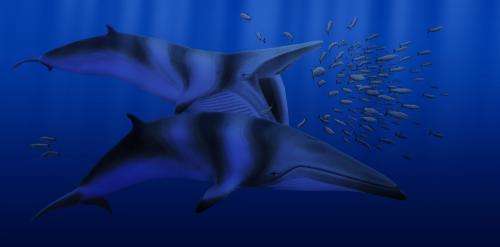Strange marine mammals of ancient North Pacific revealed

The pre-Ice Age marine mammal community of the North Pacific formed a strangely eclectic scene, research by a Geology PhD student at New Zealand's University of Otago reveals.
Studying hundreds of fossil bones and teeth he excavated from the San Francisco Bay Area's Purisima Formation, Robert Boessenecker has put together a record of 21 marine mammal species including dwarf baleen whales, odd double-tusked walruses, porpoises with severe underbites and a dolphin closely related to the now-extinct Chinese river dolphin.
Among his finds, which were fossilized 5 to 2.5 million years ago, is a new species of fossil whale, dubbed Balaenoptera bertae, a close relative of minke, fin, and blue whales.
Mr Boessenecker named the whale in honour of San Diego State University's Professor Annalisa Berta, who has made numerous contributions to the study of fossil marine mammals and mentored many students.
Although an extinct species, it belongs within the same genus as minke and fin whales, indicating that the Balaenoptera lineage has lasted for 3-4 million years. Balaenoptera bertae would have been approximately 5-6 meters in length, slightly smaller than modern minke whales, Mr Boessenecker says.
His findings appear in the most recent edition of the international journal Geodiversitas.
The publication represents eight years of research by Mr Boessenecker, who was 18 in 2004 when he was tipped off by a local surfer about bones near Half Moon Bay. When he discovered the fossil site, he was astonished by the numerous bone-beds and hundreds of bones sticking out of the cliffs.
He excavated the incomplete skull of Balaenoptera bertae during early field research there in 2005 and it was encased in a hard concretion that took five years to remove.
"The mix of marine mammals I ended up uncovering was almost completely different to that found in the North Pacific today, and to anywhere else at that time," he says.
Primitive porpoises and baleen whales were living side-by-side with comparatively modern marine mammals such as the Northern fur seal and right whales. And species far geographically and climatically removed from their modern relatives also featured, such as beluga-like whales and tusked walruses, which today live in the Arctic, he says.
"At the same time as this eclectic mix of ancient and modern-type marine mammals was living together, the marine mammal fauna in the North Atlantic and Southern Ocean were already in the forms we find today."
Mr Boessenecker says this strange fauna existed up until as recently as one or two million years ago. Its weirdness was likely maintained by warm equatorial waters and barriers to migration by other marine mammals posed by the newly formed Isthmus of Panama, and the still-closed Bering Strait.
"Once the Bering Strait opened and the equatorial Pacific cooled during the Ice Age, modernised marine mammals were able to migrate from other ocean basins into the North Pacific, leading to the mix we see today," he says.
Provided by University of Otago




















